Abstract
It has been proposed that teenage girls often smoke cigarettes to protect themselves from the impulse to binge eat, with its feared weight-gain consequences, particularly when other measures such as greater dietary restraint have failed. The present study looked at the relationship between body mass index and standardised questionnaire responses concerning smoking, alcohol consumption, moods, weight changes, attitudes to body weight and shape, dietary patterns and menstruation in 1936 British (London) and 832 Canadian (Ottawa) schoolgirls. Data analysis revealed links between cigarette smoking and body weight/shape concerns, and awareness by subjects of these links; there was also a tendency for smokers in these two populations to be overweight but not grossly obese. Smoking was also related at all ages to being postmenarchal. The London population in particular revealed an association between smoking and a weight loss of 7 kg or more at some stage since puberty. Smoking was also linked, in a minority, with regular vomiting undertaken as a further defence against weight gain when overeating had occurred. These associations existed alongside the major and predictable association found between alcohol consumption and smoking. Similarities between the British and Canadian schoolgirls were striking in respect of rank order of reasons given for smoking and consequences of giving it up. Since smoking amongst older women is reportedly associated with below-average body weight it may indeed be effective in helping to curb weight gain. Our study provided little evidence of association between smoking and generalised anxiety or social anxiety (in either population), or depression (in the British cohort). We suggest that any preventive psychological approach to teenage female smoking should include attention to weight gain anxiety and consequent pursuit of thinness.
Full text
PDF
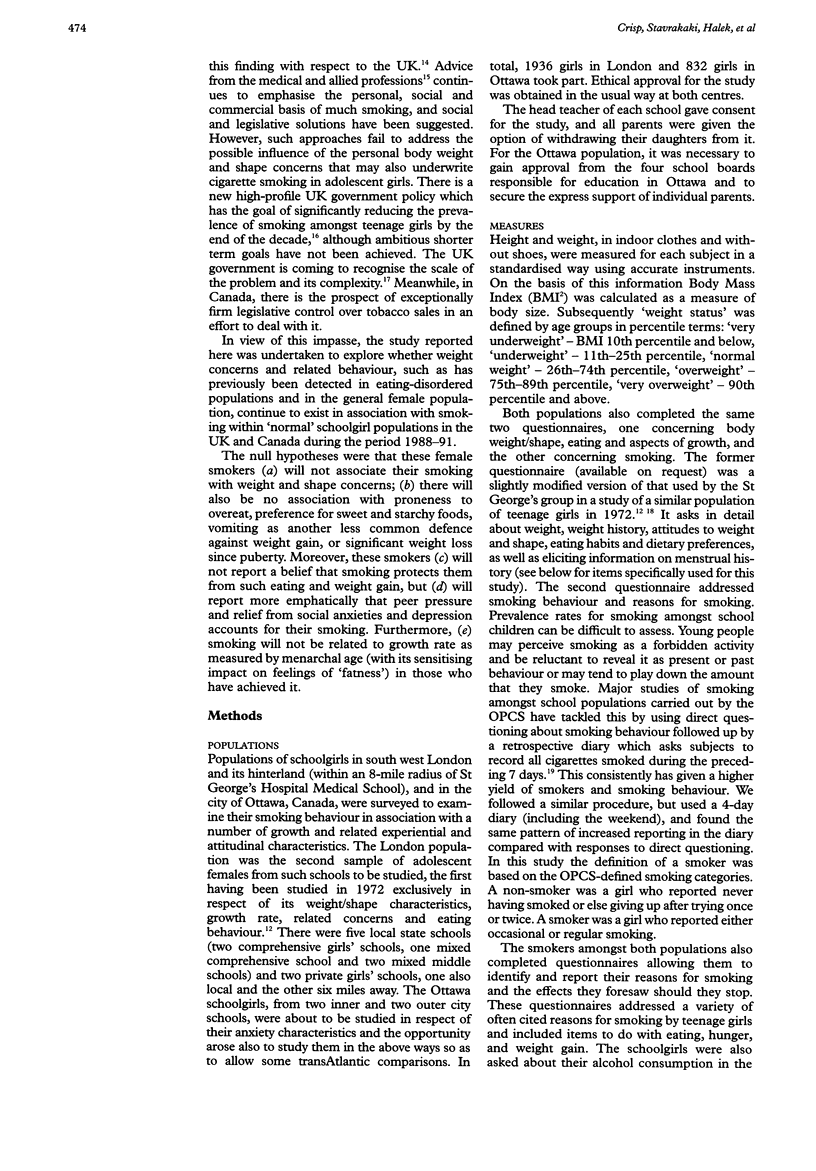

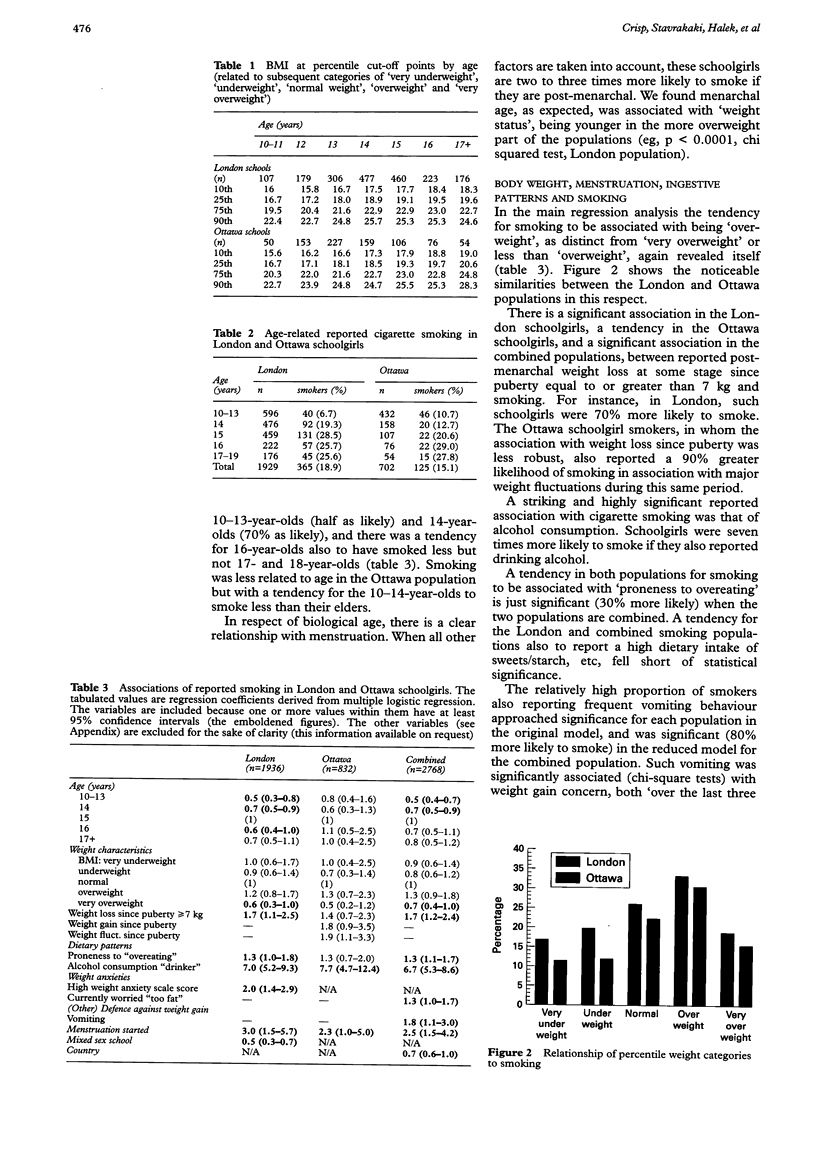
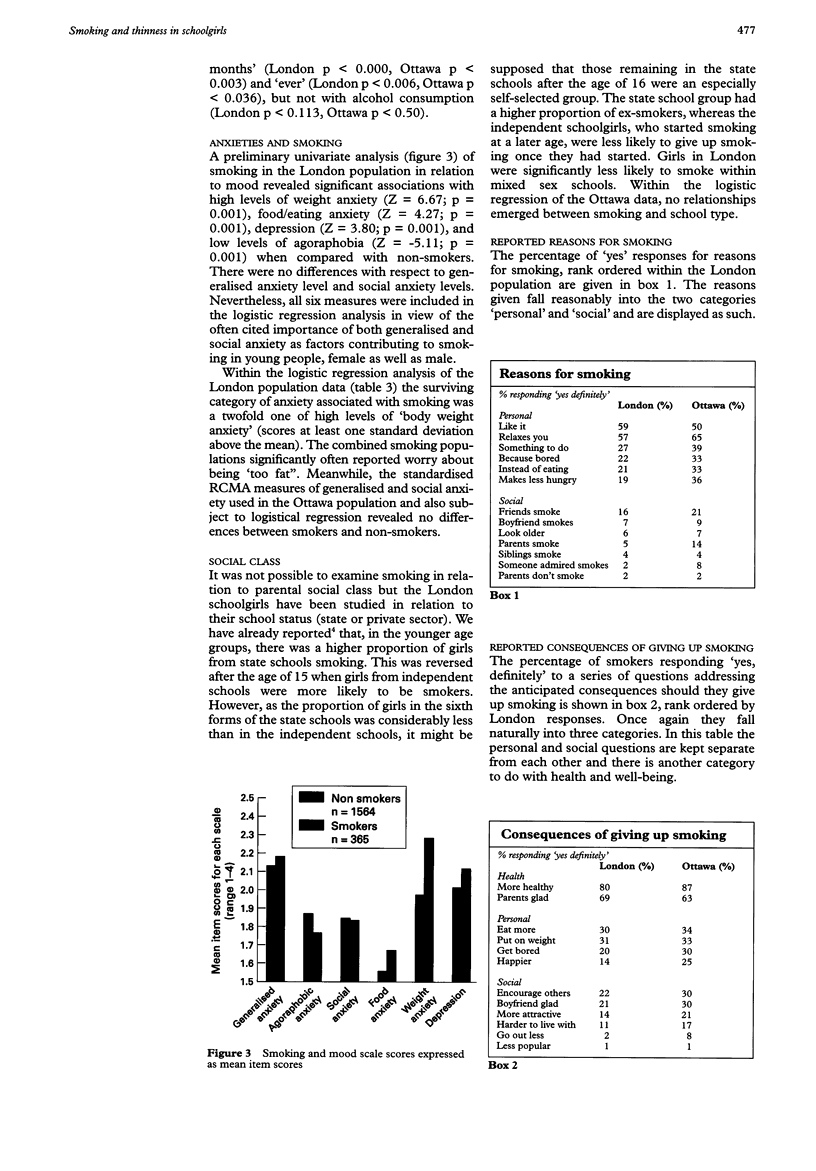
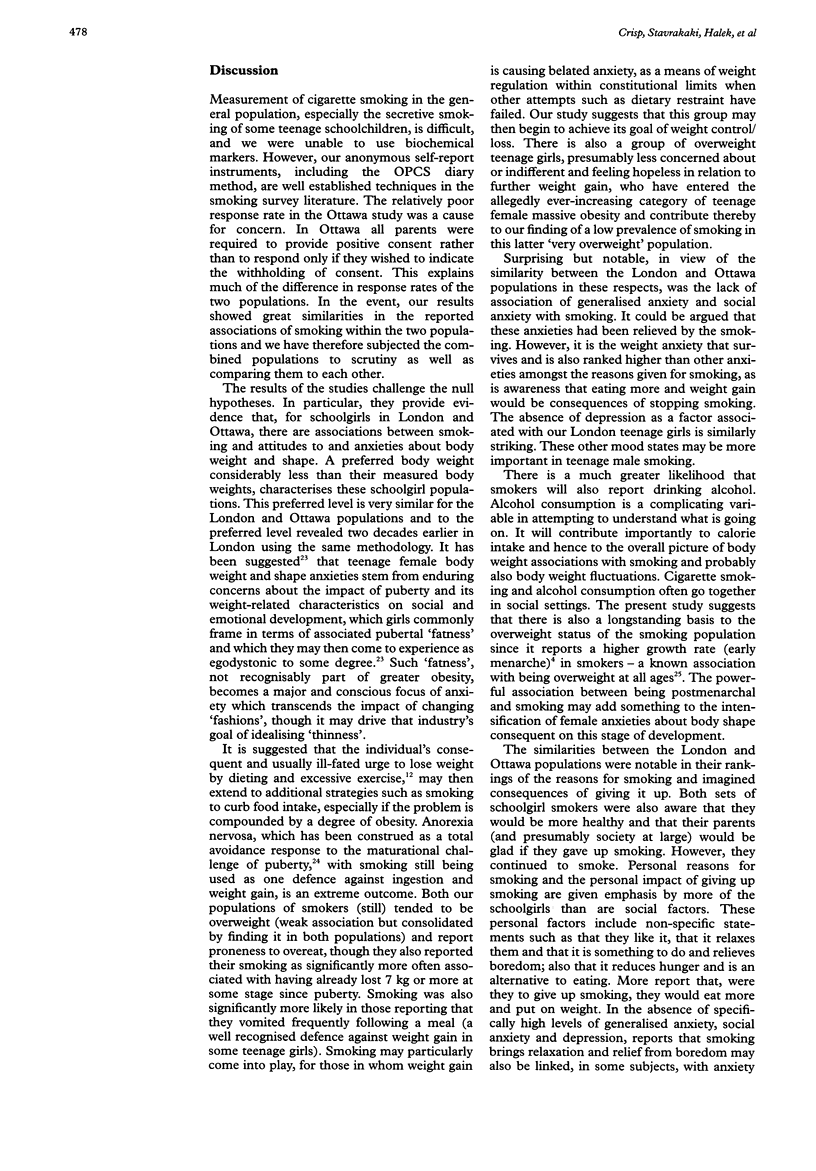
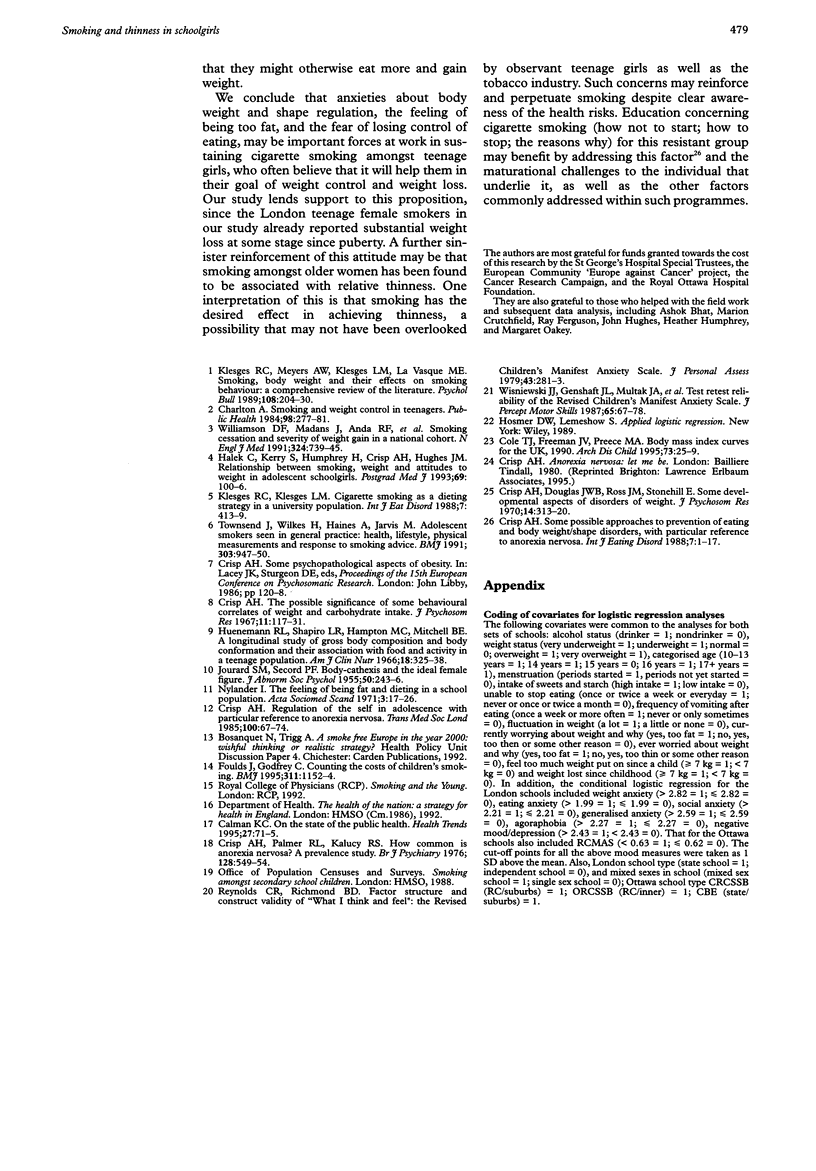
Selected References
These references are in PubMed. This may not be the complete list of references from this article.
- Calman K. On the state of the public health. Health Trends. 1995;27(3):71–75. [PubMed] [Google Scholar]
- Charlton A. Smoking and weight control in teenagers. Public Health. 1984 Sep;98(5):277–281. doi: 10.1016/s0033-3506(84)80003-7. [DOI] [PubMed] [Google Scholar]
- Cole T. J., Freeman J. V., Preece M. A. Body mass index reference curves for the UK, 1990. Arch Dis Child. 1995 Jul;73(1):25–29. doi: 10.1136/adc.73.1.25. [DOI] [PMC free article] [PubMed] [Google Scholar]
- Crisp A. H., Douglas J. W., Ross J. M., Stonehill E. Some developmental aspects of disorders of weight. J Psychosom Res. 1970 Sep;14(3):313–320. doi: 10.1016/0022-3999(70)90059-0. [DOI] [PubMed] [Google Scholar]
- Crisp A. H., Palmer R. L., Kalucy R. S. How common is anorexia nervosa? A prevalence study. Br J Psychiatry. 1976 Jun;128:549–554. doi: 10.1192/bjp.128.6.549. [DOI] [PubMed] [Google Scholar]
- Crisp A. H. The possible significance of some behavioural correlates of weight and carbohydrate intake. J Psychosom Res. 1967 Jun;11(1):117–131. doi: 10.1016/0022-3999(67)90064-5. [DOI] [PubMed] [Google Scholar]
- Foulds J., Godfrey C. Counting the costs of children's smoking. BMJ. 1995 Oct 28;311(7013):1152–1154. doi: 10.1136/bmj.311.7013.1152. [DOI] [PMC free article] [PubMed] [Google Scholar]
- Halek C., Kerry S., Humphrey H., Crisp A. H., Hughes J. M. Relationship between smoking, weight and attitudes to weight in adolescent schoolgirls. Postgrad Med J. 1993 Feb;69(808):100–106. doi: 10.1136/pgmj.69.808.100. [DOI] [PMC free article] [PubMed] [Google Scholar]
- Huenemann R. L., Shapiro L. R., Hampton M. C., Mitchell B. W. A longitudinal study of gross body composition and body conformation and their association with food and activity in a teen-age population. Views of teen-age subjects on body conformation, food and activity. Am J Clin Nutr. 1966 May;18(5):325–338. doi: 10.1093/ajcn/18.5.325. [DOI] [PubMed] [Google Scholar]
- JOURARD S. M., SECORD P. F. Body-cathexis and the ideal female figure. J Abnorm Psychol. 1955 Mar;50(2):243–246. doi: 10.1037/h0041128. [DOI] [PubMed] [Google Scholar]
- Klesges R. C., Meyers A. W., Klesges L. M., La Vasque M. E. Smoking, body weight, and their effects on smoking behavior: a comprehensive review of the literature. Psychol Bull. 1989 Sep;106(2):204–230. doi: 10.1037/0033-2909.106.2.204. [DOI] [PubMed] [Google Scholar]
- Reynolds C. R., Richmond B. O. Factor structure and construct validity of "what I think and feel": The Revised Children's Manifest Anxiety Scale. J Pers Assess. 1979 Jun;43(3):281–283. doi: 10.1207/s15327752jpa4303_9. [DOI] [PubMed] [Google Scholar]
- Townsend J., Wilkes H., Haines A., Jarvis M. Adolescent smokers seen in general practice: health, lifestyle, physical measurements, and response to antismoking advice. BMJ. 1991 Oct 19;303(6808):947–950. doi: 10.1136/bmj.303.6808.947. [DOI] [PMC free article] [PubMed] [Google Scholar]
- Williamson D. F., Madans J., Anda R. F., Kleinman J. C., Giovino G. A., Byers T. Smoking cessation and severity of weight gain in a national cohort. N Engl J Med. 1991 Mar 14;324(11):739–745. doi: 10.1056/NEJM199103143241106. [DOI] [PubMed] [Google Scholar]
- Wisniewski J. J., Mulick J. A., Genshaft J. L., Coury D. L. Test-retest reliability of the Revised Children's Manifest Anxiety Scale. Percept Mot Skills. 1987 Aug;65(1):67–70. doi: 10.2466/pms.1987.65.1.67. [DOI] [PubMed] [Google Scholar]


